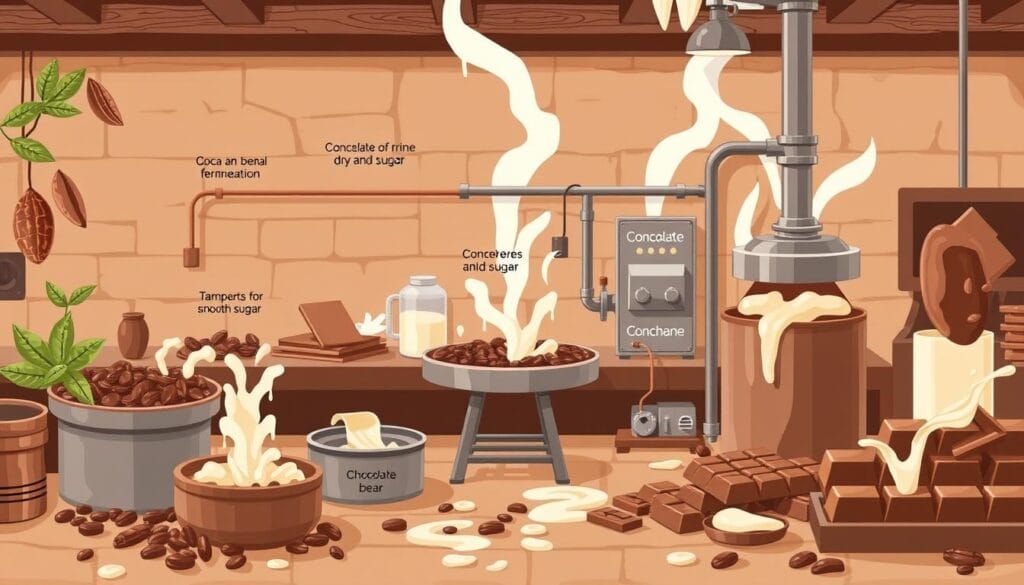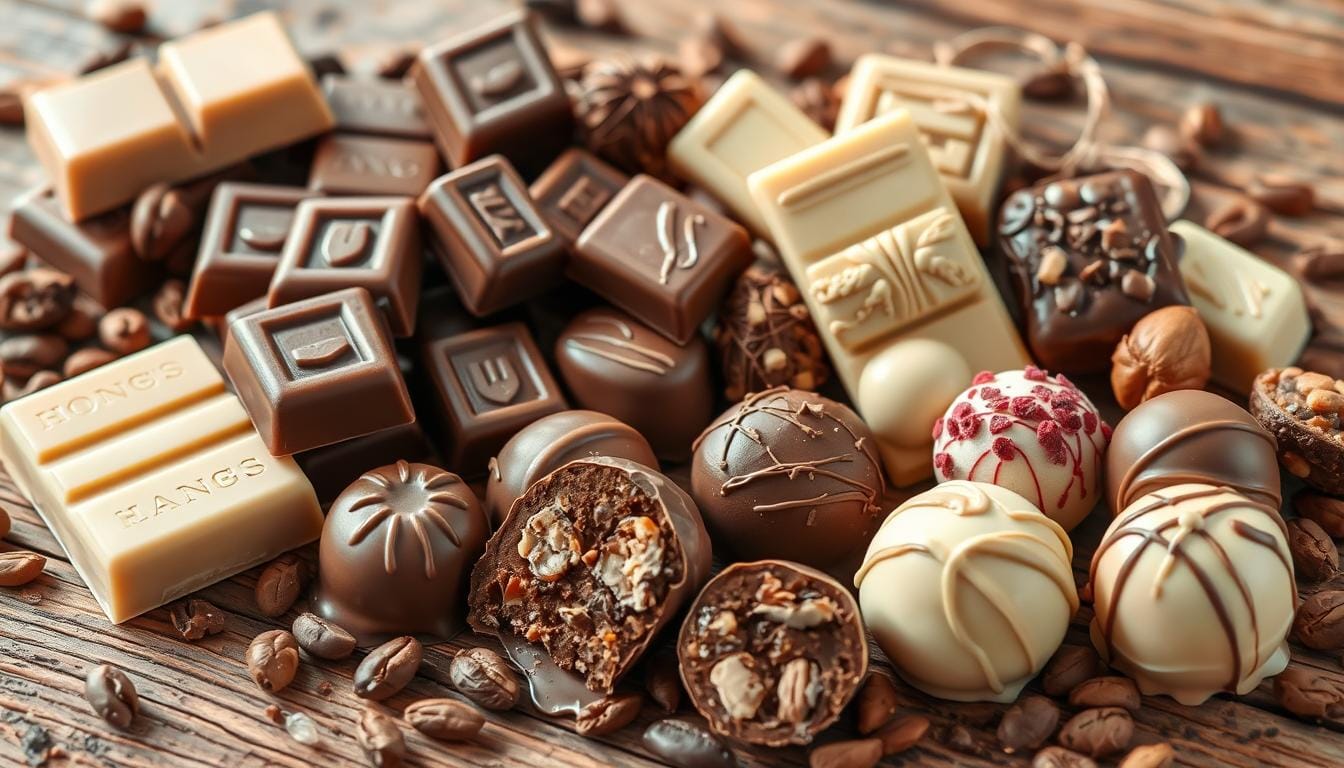Every childhood memory is linked to milk chocolate. The moment you unwrap it, memories of joy and celebration come flooding back. Americans love milk chocolate, eating 4.3 billion pounds of it every year.
Your love for milk chocolate is more than a personal treat. It’s a national favorite. With each person eating about 12 pounds a year, it’s a comfort and joy for many.
So, why do we love Smooth chocolate so much? It’s the mix of cocoa butter, sugar, and milk that wins our hearts. Brands like Hershey’s have been making us happy since 1900.
Join us on this tasty journey into the world of milk chocolate. It’s not just a food; it’s a way to connect with others and cherish memories.
The History of Milk Chocolate
Smooth chocolate has a rich and fascinating journey. It spans centuries, from its humble beginnings in South America to becoming a global favorite. This sweet treat has changed how people enjoy chocolate.
The roots of Smooth chocolate go back to indigenous people. They first cultivated cocoa beans over 5,000 years ago. These early chocolate lovers made a bitter drink called xocolatl. This drink would evolve into the smooth milk chocolate we love today.
The Origins of Milk Chocolate
The story of Smooth chocolate starts with a breakthrough in chocolate production. In 1687, the term “milk chocolate” first appeared in London. This marked the beginning of a delicious revolution. Key milestones in its development include:
- 1839: First solid milk chocolate created by Eduard Jordan and Friedrich August Timaeus
- 1875: Swiss entrepreneur Daniel Peter developed the solid milk chocolate recipe
- 1905: Dairy Milk Chocolate introduced with a unique formula
Evolution Over the Years
The transformation of Smooth chocolate was remarkable. Swiss manufacturers played a crucial role in perfecting the recipe. They balanced cocoa solids and milk solids to create a creamy, delectable treat. By 1905, Switzerland was producing 15,000 tonnes of milk chocolate annually.
Milton Hershey revolutionized milk chocolate in the United States. He made it affordable. His Smooth chocolate bars were sold for just 2 to 10 cents. This turned chocolate from a luxury item into an everyday indulgence enjoyed by millions.
The Smooth chocolate we love today is a testament to centuries of innovation. It blends the rich history of cocoa with the creamy smoothness of milk. From its bitter beginnings to a globally cherished sweet, milk chocolate continues to capture hearts and taste buds around the world.
What Makes Milk Chocolate So Special?
Smooth chocolate is loved for its unique mix of ingredients and delicious taste. It’s a favorite among chocolate fans across the country. The science behind it explains why it’s so popular.
The Unique Ingredients
The secret of Smooth chocolate is in its special ingredients. Let’s look at what makes it so special:
- Cocoa solids (10-50% of content): Provide the core chocolate flavor
- Sugar (20-50%): Balances the cocoa’s natural bitterness
- Milk solids: Create the signature creamy texture
- Emulsifiers: Ensure smooth consistency
Smooth Texture and Flavor
Chocolatiers use special methods to make milk chocolate smooth. Emulsifiers like lecithin help avoid grittiness. Vanilla adds to the rich taste.
| Ingredient | Percentage | Role in Milk Chocolate |
|---|---|---|
| Cocoa Solids | 10-40% | Primary flavor source |
| Sugar | 20-50% | Sweetness and balance |
| Milk Solids | 20-30% | Creamy texture |
Smooth chocolate is a hit. In 2023, 49% of consumers in the United States preferred Smooth chocolate. Its unique ingredients and careful making make it a special treat.
The Nutritional Benefits of Milk Chocolate
Smooth chocolate is more than just a tasty treat. It has surprising nutritional benefits that might make you see it in a new light. Often thought of as just a sweet indulgence, milk chocolate actually has important nutrients for your health.
Smooth chocolate is full of special ingredients like cocoa butter and milk solids. These give it more than just a sweet taste. Let’s look at what makes this chocolate so nutritious:
- Contains approximately 535 calories per 100 grams
- Provides 8 grams of protein from milk solids
- Offers around 190 milligrams of calcium per 100 grams
- Contains modest amounts of magnesium and iron
Healthier than You Think
Your favorite Smooth chocolate isn’t just empty calories. It has healthy fats from cocoa butter and important nutrients from milk solids. While dark chocolate gets more health praise, Smooth chocolate has its own benefits.
Containing Essential Nutrients
Smooth chocolate can make you feel good by releasing endorphins. It has minerals and compounds that make it more than just a sweet treat. But, remember to enjoy it in moderation because of its high sugar content.
Experts say to eat milk chocolate in small amounts. Its glycemic index of 45 means it doesn’t raise blood sugar too much. This makes it a better choice than some other desserts.
How Milk Chocolate Is Made
Making Smooth chocolate is a cool process that turns simple cacao beans into a treat we all love. It shows the skill behind every tasty bite.

The journey starts with picking the best cacao beans. These special beans go through a detailed change that needs both precision and skill.
The Chocolate-Making Process
Here’s how Chocolate with milk is made:
- Harvesting cacao pods from tropical places
- Fermenting and drying the cacao beans
- Roasting beans to bring out rich flavors
- Removing bean shells to get chocolate liquor
- Grinding beans into a smooth paste
- Mixing with milk and sugar
Quality Control in Production
Making sure Smooth chocolate is top-notch is a big deal. Companies watch every step to keep the taste and feel the same. The Hershey Company, for example, uses milk from farms close to their factory for freshness.
Some cool facts about production are:
- 17,000 cows are milked daily for HERSHEY’S Milk Chocolate
- Cacao beans come from all over to add unique tastes
- A little salt can make chocolate taste even better
The secret to milk chocolate’s smoothness is in its mix. It usually has cacao butter, cacao powder, sugar, and milk powder. Each part is key to its creamy feel.
Popular Brands of Milk Chocolate
America is home to a wide range of delicious Smooth chocolate brands. These brands offer everything from classic favorites to luxury treats. They cater to all chocolate enthusiasts.
The Smooth chocolate market is filled with diverse options. Each brand has its own special flavors and ways of making chocolate. Here are some top brands that stand out:
Hershey’s: A Classic American Choice
Milton S. Hershey started Hershey’s in 1894. He made Smooth chocolate more accessible. Hershey’s is known for its smooth taste and just the right amount of sugar.
This brand turned chocolate into a treat everyone could enjoy. It’s a true American chocolate classic.
- Price point: $1.32 for a 1.55-ounce bar
- Known for consistent quality and affordable pricing
- Uses carefully selected cocoa solids and milk ingredients
Cadbury: A Global Favorite
Cadbury adds a touch of international flair to Smooth chocolate. Their Dairy Milk line is creamy and rich, loved by many around the world. Cadbury focuses on using top-quality ingredients and a smooth texture.
- Priced at $3.49 for a 3.5-ounce bar
- Renowned for its distinctive, creamy milk chocolate
- Uses premium cocoa solids and carefully balanced sugar
Ghirardelli: A Touch of Luxury
Ghirardelli offers a more refined Smooth chocolate experience. This San Francisco brand is all about quality. They make milk chocolate with great care, creating complex flavors.
- Known for premium ingredients
- Offers complex flavor combinations
- Emphasizes artisanal chocolate-making techniques
When choosing Smooth chocolate, think about what you like, how much you want to spend, and the flavor you’re after. Each brand offers something special.
The Science Behind Milk Chocolate
Smooth chocolate is a mix of science and cooking art. The chemical processes behind it explain why we love it so much. It’s the mix of cocoa butter, milk solids, and other ingredients that makes it so tasty.
The Role of Cocoa in Smooth chocolate
Cocoa is key in milk chocolate’s flavor. It starts with special cocoa beans that go through many steps. Fermentation and roasting change the chocolate’s taste. Milk chocolate has 10-50% cocoa, giving it a rich taste and smooth feel.
- Cocoa content must be at least 31% to be classified as real chocolate
- Fermentation and roasting are key steps in developing flavor
- Temperature control is critical during chocolate production
How Milk Affects the Flavor Profile
Milk solids make chocolate creamy and delicious. Milk-based chocolate needs at least 12% milk solids. This makes it taste smoother and more friendly than dark chocolate.
| Chocolate Type | Milk Solids | Melting Point |
|---|---|---|
| Milk Chocolate | 12-14% | Lower (around 93°F) |
| Dark Chocolate | 0% | Higher (around 100°F) |
The Maillard reaction adds flavor depth. Cocoa butter’s melting point (around 93°F) makes Smooth chocolate melt well. This gives a rich taste experience.
Milk Chocolate vs. Dark Chocolate
Chocolate lovers often debate the merits of Smooth chocolate and dark chocolate. Each type offers a unique taste experience that appeals to different palates. Understanding the differences can help you choose the perfect sweet treat for your mood and health goals.
The primary distinctions between Smooth chocolate and dark chocolate lie in their composition and flavor profiles. Smooth chocolate typically contains between 10% to 50% cocoa solids, while dark chocolate must contain at least 55% cacao to earn its label.
Taste Profiles: A Flavor Journey
Smooth chocolate stands out with its creamy, sweet character. The addition of whole milk powder creates a velvety texture that melts smoothly on your tongue. In contrast, dark chocolate offers a more intense, slightly bitter flavor that chocolate enthusiasts appreciate.
- Milk chocolate: Sweeter, creamier texture
- Dark chocolate: More intense, less sweet flavor
- Sugar content: Milk chocolate contains more sugar
Nutritional Considerations
When it comes to health benefits, dark chocolate takes the lead. Its higher cocoa content means more beneficial compounds like antioxidants and trace minerals.
| Characteristic | Milk Chocolate | Dark Chocolate |
|---|---|---|
| Cocoa Content | 10-50% | 55-70%+ |
| Sugar Level | Higher | Lower |
| Antioxidants | Lower | Higher |
Interestingly, 49% of adult Americans still prefer Milk-based chocolate, despite dark chocolate’s growing popularity. The creamy sweetness of Milk-based chocolate continues to win hearts across the country.
Whether you prefer the rich complexity of dark chocolate or the smooth sweetness of Milk-based chocolate, both offer a delightful indulgence. Your choice depends on personal taste and nutritional preferences.
Creative Ways to Enjoy Chocolate with milk
Chocolate with milk is more than just a treat. It’s a versatile ingredient that can change how you cook and bake. Whether you love baking or just enjoy trying new flavors, Milk-based chocolate can make your dishes special.
Delicious Recipes to Explore at Home
Ready to become a kitchen master with Smooth chocolate? Hershey’s has many baking products to help you. You can make everything from classic cookies to new desserts with Smooth chocolate.
- Milk chocolate brownies with sea salt
- Chocolate-dipped fruit platters
- Milk chocolate truffles with flavor enhancers
- Homemade chocolate bark with nuts and dried fruits
Exciting Flavor Pairings to Try
Discover new tastes by mixing Milk-based chocolate with unique ingredients. The right mix can turn your sweets into a gourmet treat.
| Ingredient | Pairing Experience |
|---|---|
| Lavender | Floral, delicate flavor profile |
| Sea Salt | Rich contrast of sweet and savory |
| Chili Peppers | Spicy heat with creamy chocolate |
| Caramel | Smooth, indulgent combination |
Pro tip: Try Smooth chocolate with dessert wines like Port for a fancy taste. About 70% of people love this mix.

Remember, Smooth chocolate lets you be creative in the kitchen. Don’t be afraid to try new things and find your favorite flavors!
Milk Chocolate in American Culture
Milk-based chocolate is more than a sweet treat in the United States. It’s a big part of our culture, found in holidays and special moments. It brings comfort and joy to millions of Americans.
Many Americans have a strong emotional bond with Milk-based chocolate. Almost half of them say it’s their favorite sweet treat. This shows how important it is in our culture. With 62% of chocolate lovers in the U.S. preferring Smooth chocolate, its popularity keeps growing.
Celebrating Holidays with Milk Chocolate
Holidays are the perfect time for Milk-based chocolate to shine. Think about these special moments:
- Valentine’s Day sees $2 billion spent on chocolate gifts
- Halloween accounts for 25% of chocolate industry sales
- Seasonal milk chocolate products like Hershey’s Milk Chocolate Hearts and Pumpkins become tradition
Emulsifiers and cocoa butter make milk chocolate smooth. This makes seasonal treats even more tempting. Brands create special chocolates for each holiday, capturing its spirit.
Milk Chocolate in Film and Literature
Milk-based chocolate also has a special place in American stories. Films and books often use it to symbolize nostalgia, comfort, and emotional connection. It’s more than just a confection – it’s a cultural touchstone that brings warmth and memories.
Whether enjoyed during movie nights, given as gifts, or savored alone, Milk-based chocolate is a beloved part of American culture. It connects generations with its sweet, creamy essence.
The Popularity of Milk Chocolate in the U.S.
Smooth chocolate is a big hit in America, loved by many. It’s known for its rich and creamy taste. This favorite treat is a big part of American snacking.
Market Trends and Consumer Preferences
The U.S. chocolate market shows interesting trends. 40% of Americans choose milk chocolate first. The chocolate market has grown to $21.4 billion in sales.
- 94% of consumers buy chocolate for themselves
- 72% see chocolate as part of a healthy life
- 65% think chocolate is an affordable treat
Regional Favorites Across the States
Chocolate tastes vary by region in the U.S. Creamy chocolate is still the favorite, but tastes differ.
| Region | Chocolate Preference | Consumption Frequency |
|---|---|---|
| Northeast | Slight preference for dark chocolate | High |
| Midwest | Lower overall chocolate consumption | Moderate |
| National Average | Milk chocolate | 1-2 times per week |
The milk chocolate market is always changing. People want treats that are both tasty and healthy. New cocoa and sweetener options are leading to exciting new flavors.
How to Choose the Best Milk Chocolate
Finding the perfect Creamy chocolate is more than just picking any bar. It’s about understanding the details of Smooth chocolate. This knowledge helps you find your favorite treat.
Reading Labels Like a Pro
When looking at Creamy chocolate, check the ingredients carefully. Good Smooth chocolate starts with cocoa butter, not vegetable oils or fake flavor enhancers. Choose chocolates with simple ingredients that show off natural tastes.
- Check cocoa percentage (typically 30-50% for milk chocolate)
- Verify cocoa butter content
- Avoid excessive artificial additives
- Look for single-origin chocolate varieties
Understanding Your Personal Chocolate Preferences
Everyone likes chocolate differently. Some like it very sweet, while others prefer more complex tastes. Try different brands to find what you love.
| Chocolate Characteristic | Flavor Profile | Recommended Percentage |
|---|---|---|
| Sweet and Creamy | Mild, smooth texture | 30-40% |
| Rich and Complex | Deeper cocoa notes | 40-50% |
| Balanced Flavor | Nuanced chocolate experience | 35-45% |
Premium brands like Ghirardelli and Lindt are great for chocolate lovers. Remember, quality is more important than quantity when picking your milk chocolate.
The Future of Milk Chocolate
The world of Creamy chocolate is changing fast, with new ways to enjoy this favorite treat. With cocoa prices over $10,000 per metric ton, makers are finding ways to keep costs down without sacrificing quality. Hershey’s is at the forefront, working on sustainable chocolate and using certified cacao beans to help the planet.
What we want from Smooth chocolate is changing too. Now, you can find bars, chips, and wafers in unique flavors and shapes. The market is expected to grow, reaching $34.58 billion by 2032, showing more people want high-quality, eco-friendly chocolate.
Innovations in Flavors and Textures
Chocolate makers are getting creative, adding new ingredients and flavors from around the world. Expect to see more unique blends that mix traditional chocolate with global tastes. They’re focusing on textures and tastes that excite those looking for something new.
Sustainability in Chocolate Production
Making Creamy chocolate in a sustainable way is now key. Companies face issues like climate change and aging farmers. They’re working on ethical sourcing and protecting the environment. Look for more information on where your chocolate comes from and how it’s made in the future.

